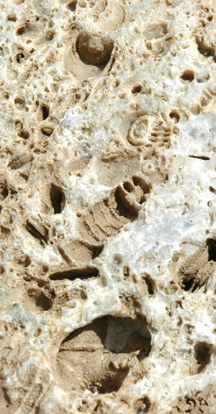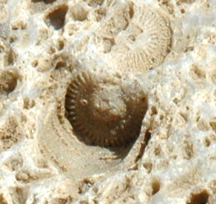
![]()
Permian Crinoid Ossicles
Other names: Sea Lilies.
Photo 1: Permian crinoids eroded out of a cliff face.
Crinoids, which are commonly known as sea lilies, are echinoderms and hence relatives of starfish, sea cucumbers, and sea urchins. They are suspension feeders that attach themselves to rocks via a stem. It is generally fragments of these stems that are present as fossils in limestone formations today. These stems are made of discs called ossicles.
Although, crinoids are rare today, they were a dominant life form in shallow Paleozoic seas. Nearly, every hole in the picture to the right is a remnant of a crinoid ossicle. Crinoids almost completely disappeared at the Permian-Triassic extinction. Most modern day crinoids are found in deep water.
Fossilized crinoid stems are quite common in Vancouver Island limestones. I have encountered them throughout Buttle Lake at various locations including Karst Creek, the Flower Ridge Trail, Marble Meadows, the mouth of Phillips Creek and other locations in the mountains surrounding Buttle Lake. I have also seen them in the Horne Lake Caves and a few other places. Where they are present, they are present in abundance. The Permian sea floor must have been covered in them. They are usually the only thing you find, though on a rare occasion you also find some bryozoans.
Photo 2: Close up of crinoid ossicle.
The best examples of Permian crinoid stems are found within the boundaries of Strathcona Park, which, unfortunately, means you can take photos but that's about it. It is illegal to collect fossils from a provincial park without a permit in British Columbia.
Illustration 1: Cross section of crinoid ossicle.
Note the star shaped symmetry of the stem cross section. Five-rayed radial symmetry is a defining characteristic of echinoderms.



